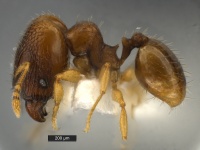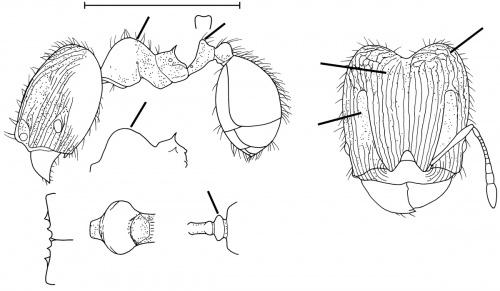Pheidole ademonia
| Pheidole ademonia | |
|---|---|

| |
| Scientific classification | |
| Kingdom: | Animalia |
| Phylum: | Arthropoda |
| Class: | Insecta |
| Order: | Hymenoptera |
| Family: | Formicidae |
| Subfamily: | Myrmicinae |
| Tribe: | Attini |
| Genus: | Pheidole |
| Species: | P. ademonia |
| Binomial name | |
| Pheidole ademonia Wilson, 2003 | |
Two series were collected at the type locality in terra firme forest. One was a small group of ants found beneath the bark of a rotten log, the other several strays in soil (Stefan Cover, unpublished notes).
Identification
See the description in the nomenclature section.
Keys including this Species
Distribution
Known from the type locality in Peru and from several series collected at the Yasuni National Park, Ecuador. (Wilson 2003)
Latitudinal Distribution Pattern
Latitudinal Range: 4.732° to -12.497473°.
| North Temperate |
North Subtropical |
Tropical | South Subtropical |
South Temperate |
- Source: AntMaps
Distribution based on Regional Taxon Lists
Neotropical Region: Ecuador, Guyana, Peru (type locality).
Distribution based on AntMaps
Distribution based on AntWeb specimens
Check data from AntWeb
Countries Occupied
| Number of countries occupied by this species based on AntWiki Regional Taxon Lists. In general, fewer countries occupied indicates a narrower range, while more countries indicates a more widespread species. |

|
Estimated Abundance
| Relative abundance based on number of AntMaps records per species (this species within the purple bar). Fewer records (to the left) indicates a less abundant/encountered species while more records (to the right) indicates more abundant/encountered species. |

|
Biology
Castes
Nomenclature
The following information is derived from Barry Bolton's Online Catalogue of the Ants of the World.
- ademonia. Pheidole ademonia Wilson, 2003: 365, figs. (s.w.) PERU.
Unless otherwise noted the text for the remainder of this section is reported from the publication that includes the original description.
Description
A small yellow member of the flavens group, similar to Pheidole infernalis, Pheidole peltastes, Pheidole sospes and Pheidole termitobia, distinguished by the following combination of traits.
Major: Antennal scrobe present, its surface weakly foveolate; occiput rugoreticulate, with remainder of dorsal head surface longitudinally carinulate; carinulae near the cephalic midline curving inward; promesonotal dorsal profile forms a single high, semicircular curve.
Minor: Almost identical to that of Pheidole sospes (see illustration of that species).
MEASUREMENTS (mm) Holotype major: HW 0.74, HL 0.80, SL 0.36, EL 0.06, PW 0.34. Paratype minor: HW 0.38, HL 0.40, SL 0.34, EL 0.06, PW 0.24.
COLOR Major: Concolorous medium reddish yellow.
Minor: Concolorous plain medium yellow.
Figure. Holotype Major. Scale Bar = 1mm.
Type Material
PERU: Cuzco Amazónico, 15 km northeast of Puerto Maldonado, Madre de Dios, col. Stefan Cover and John E. Tobin. Museum of Comparative Zoology
Etymology
Gr ademonia, troubled, distressed.
References
- Wilson, E. O. 2003. Pheidole in the New World: A dominant, hyperdiverse ant genus. Harvard University Press, Cambridge, MA. (page 365, fig. major, minor described)
References based on Global Ant Biodiversity Informatics
- Fernández, F. and S. Sendoya. 2004. Lista de las hormigas neotropicales. Biota Colombiana Volume 5, Number 1.
- LaPolla, J.S. and S.P. Cover. 2005. New species of Pheidole (Hymenoptera: Formicidae) from Guyana, with a list of species known from the country. Tranactions of the American Entomological Society 131(3-4):365-374
- Mertl A. L., J. F. A. Traniello, K. Ryder Wilkie, and R. Constantino. 2012. Associations of two ecologically significant social insect taxa in the litter of an amazonian rainforest: is there a relationship between ant and termite species richness? Psyche doi:10.1155/2012/312054


